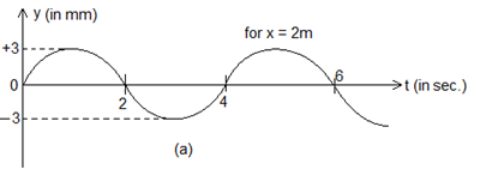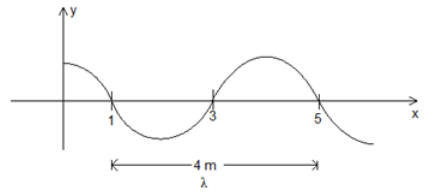Waves On A String(11th And 12th > Physics ) Questions and Answers
Explanation:-
Answer: Option B. -> y=5sin(π3x−4πt):
B
here λ=6m
∴ k=2π6=π3
ω=2πT=2π0.5=4π
given,amplitude =5m
y=5 sin(π3x−4πt)
[the standard equation is y=Asin(kx-ω t)]
Explanation:-
Answer: Option B. -> amplitude A2, frequency ωπ:
B
y=Asin2(kx−ωt)
This is not ideal equation of wave we don't have sin2θ in ideal equation so let's remove the square.
Use trigonometry
cos2θ=cos2θ−sin2θ
=1−2sin2θ
sin2θ=1−cos2θ2
y=A{1−cos2(kx−wt)2}2
y=A2−A2cos(2kx−2ωt)
y′=(y−A2)=−A2cos(2kx−2ωt)
So amplitude =−A2
angular frequency(ω′)=2ω
frequency(f)=ω2π=2ω2π=ωπ
Explanation:-
Answer: Option C. -> 4m, 0.25 Hz, 1 ms−1, 1.5 πmms−1, 0.75 π2mms−2:
C
From the y-t graph we can see the wave repeats itself on interval of 4s. So the time period is 4s. from the y-x graph we see that the distance between the points after which the wave repeats itself is 4m. Hence the wave length is 4m.
f=1T=14S−1=0.25s−1
v=λf=414=1 ms−1
vp max=Aω
=A×(2πf
=3××2π×0.25 [A=3 from y vst graph]
apmax=ω2A
=(2π×0.25)2×3
34π2=0.075 π2mms−2
Explanation:-
Answer: Option C. -> g(x)=A sin(x−vta):
C
Given shape of the wave at t=0
g(x)=A sin(xa)
let's say the wave looks like
It's wave speed is v. After time t, the wave would have moved vt.
Now if at t = 0
The equation is g(x) = A sin(xa)
This wave was at x = x, t= t will be same as the wave at x= x-vt at t = 0
So at t = 0 g(x) = A sin x−vta
Alternate Solution:- Given g(x) = A sin (xa)
General equation A sin (kx - ωt)
Explanation:-
Answer: Option B. -> A sin[x−v(t−t0)a]:
B
Here given is g(x,t0)=A sin(xa) at t = t0
Comparing with the general equation g(x,t)=A sin(kx−ωt+ϕ)
We get at t = t0
k=1a
also−ωt0+ϕ=0
⇒ ϕ=ωt0
We also known that k=ωv
⇒ω=va
so we get
g(x,t)=A sin(xa−vta+vt0a)
g(x,t)=A sin[xa−vta+vt0a]
=A sin(x−v(t−t0)a)
Explanation:-
Answer: Option B. -> (i) - (q); (ii) - (r); (iii) - (p); (iv) - (s):
B
The standard wave equation for a wave is y = A sin (kx −ωt)
Given equation y = 3 sin 6.28 (0.5x −50t)
⇒ y = 3 sin (6.28 × 0.5x − 6.28× 50 t)
Comparing we get
amplitude A = 3 cm
Right here, we can see that B is the only possible option, but we may as well calculate the other values too.
Wave number k=2πλ=6.28×0.5
⇒ λ =2πk=2cm
Angular frequency ω=6.28×50
Frequency f=1T=ω2π=6.28×502×3.14
f=50 Hz
wave speed =λT=2×50=100cms
On December 2006, a great earthquake occurred off the coast of Sumatra and triggered immense waves (Tsunami) that killed some 200,000 people. Satellites observing these waves from space measured 800 km from one wave crest to the next and a period between waves of 1 hr. what was the speed of the wave?
Explanation:-
Answer: Option C. -> 800 km/hr:
C
crest to crest distance is wavelength λ = 800 km
Time period: Time taken for wave to travel a distance of one wavelength = 1 hr
Wave velocity = DistanceTime = 1wavelength(λ)Time period(T)
800 km1 = 800 km/hr
Consider two waves passing through the same string. Principle of superposition for displacement says that the net displacement of a particle on the string is sum of the displacements produced by the two waves individually. Suppose we state similar principles for the net velocity of the particle and the net kinetic energy of the particle. Such a principle will be valid for
Explanation:-
Answer: Option B. -> The velocity but not for the kinetic energy:
B
According to principle of super position
⃗ynet=→y1+→y2
Here y1&y2 are particle displacement vectors
differentiating with respect to time.
d⃗ynetdt=d→y1dt+d→y2dt
⃗vnet=⃗v1+⃗v2
Here velocities are vectors.
So yes the superposition law is applicable to velocities.
Now let us square both sides
(vnet)2=(⃗v1+⃗v2)2
v2net=v12+v22+2v1v2 (all are magnitudes)
So clearly the law of super position is not applicable for net kinetic energy.




